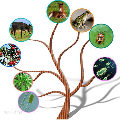Internet of Things (IoT) is one of the fastest emerging networking paradigms enabling a large number of applications for the benefit of mankind. Advancements in embedded system technology and compressed IPv6 have enabled the support of IP stack in resource constrained heterogeneous smart devices. However, global connectivity and resource constrained characteristics of smart devices have exposed them to different insider and outsider attacks, which put users' security and privacy at risk. Various risks associated with IoT slow down its growth and become an obstruction in the worldwide adoption of its applications. In RFC 6550, the IPv6 Routing Protocol for Low Power and Lossy Network (RPL) is specified by IETF's ROLL working group for facilitating efficient routing in 6LoWPAN networks, while considering its limitations. Due to resource constrained nature of nodes in the IoT, RPL is vulnerable to many attacks that consume the node's resources and degrade the network's performance. In this paper, we present a study on various attacks and their existing defense solutions, particularly to RPL. Open research issues, challenges, and future directions specific to RPL security are also discussed. A taxonomy of RPL attacks, considering the essential attributes like resources, topology, and traffic, is shown for better understanding. In addition, a study of existing cross-layered and RPL specific network layer based defense solutions suggested in the literature is also carried out.
翻译:内置系统技术和压缩IPv6的升级使IP堆积得以支持资源受限的多种智能设备。然而,全球连通性和智能设备资源受限的特点使他们暴露于不同内部人和外部人的攻击中,使用户的安全和隐私受到威胁。与IoT相关的各种风险减缓了其增长速度,并成为全世界采用其应用的障碍。在RFC 6550中,IPv6 低功率和失耗网络路标协议(RPL)是由IETF的ROLL工作组规定的,目的是促进6LWPAN网络的有效运行,同时考虑到其局限性。由于IoT中节点的资源受限性质,RPL容易受到许多攻击,消耗节点资源,降低网络的性能。在本文件中,我们介绍了关于各种袭击及其现有防御解决方案的研究,特别是RPL。 公开研究问题、挑战、以及针对RPL安全的未来方向,也讨论了LWPAN网络的有效运行路线,同时讨论了LPL网络的基本特性和结构研究。</s>




